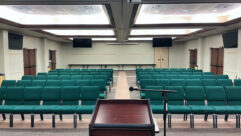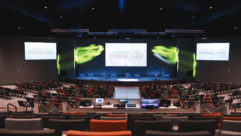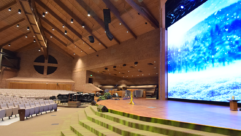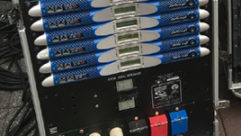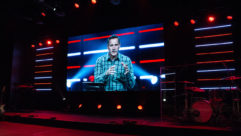
A Church From Scratch
A brand-new processor and building were two major challenges at New Life Assembly.
Challenge: Turn a new metal building into a church sanctuary with a studio-quality acoustics.
A Yamaha LS9-32, 48-channel digital console is among the improvements at New Life Assembly Church in Henrietta, N.Y.
Solution: Use DSP-controlled loudspeakers and a variety of diffusing materials to create a warm, consistent sound for both hymns and rock.
At houses of worship, some things never change. They tend to be filled with pews and other hard surfaces that can wreak havoc with acoustics. That was the case at the New Life Assembly Church in Henrietta, N.Y., where acoustical consultant AVL Designs had to create a warm-sounding sanctuary that worked equally well for an 80-voice choir and rock ‘n’ roll contemporary services.
The room had to sound good enough to pass muster with Pastor Kirk Spite, who knows a thing or two about acoustics.
“He’s produced a number of CDs, and they do multitrack recording,” says Seth Waltz, president of AVL in Penfield, N.Y. “When they decided to build a new sanctuary, we knew they wanted a very high-tech, almost recording-studio-quality audio system. They weren’t looking for just a run-of-the-mill church PA.”
Although AVL had worked with New Life before, there were a few things different about this project. One was the types of music and instruments, which created additional acoustical considerations. “They use electronic drums, all sorts of electronic keyboards, and an 80-voice choir,” says Waltz. “They also decided that in the new sanctuary, they wanted to go to acoustic drums.”
To achieve the studio-monitor sound that New Life wanted, AVL chose EAW AX loudspeakers for the main system, along with four models of QSC PLX amplifiers. “We looked at a number of technologies,” says Waltz. “The EAW is the closest thing to a studio monitor out of an all-in-one box that we’ve ever listened to.”
The AX loudspeakers include Gunness Focusing, a processing technique that mitigates audible artifacts such as horn honk and woofer ring. Those problems detract from the listening experience by, for example, creating harshness at high frequencies.
“It’s not a pleasant experience,” says Waltz. “EAW has found a way to fix those elements to a great degree, so that the horns sound almost like a dome tweeter. The woofer doesn’t have that traditional low- and midrange mud that you get out of most 12- or 15-inch drivers when they’re trying to go up and get anywhere close to a horn.”
EAW’s UX8000 processor handles the signal processing that makes this possible. At the time, New Life was one of the first two commercial installations to use the processor. Although the Gunness Focusing software was finished at the time of the project, EAW still was refining the field-tuning software, so it sent Rich Frembes, product requirements manager, to do the tuning.
Frembes tuned the system a few days before the church was outfitted with pews and other furnishings. As a result, he was working in what was essentially a giant, empty box. “Even in that environment, the acoustics were quite nice,” says Frembes. “Seth and company did a great job with acoustical treatments.”
Because the project involved a brand-new building, AVL had more flexibility specifying and installing building materials than if the firm were working in an existing space. “We have some acoustical panels to trim out some of the reverberation and midrange,” says Waltz. “We have some acoustical treatments above the ceilings that are actually a series of clouds, so that we capture all of the air above the ceiling to help control the room. Their original design was all hard, smooth, noncurved gypsum, which would have been a real problem.”
Under The Gunn
For More Information
For the main system at the New Life Assembly church in Henrietta, NY, acoustical consultant AVL Designs used EAW’s AX loudspeakers with Gunness Focusing, a processing technique that mitigates artifacts such as horn honk and woofer ring.
To develop Gunness Focusing, EAW first had to create proprietary spectrograph software that could render a picture of the high- and low-frequency anomalies often found in horn-loaded loudspeakers. That picture let EAW pick out anomalies that are linear, time invariant, and spatially consistent, making them correctable. EAW then developed digital signal processing algorithms that acted as filters to weed out the anomalies.
“With Gunness Focusing, usually when you look at the phase characteristics in SmaartLive of whatever loudspeaker you’re working with, getting a relatively flat phase characteristic out of even a single speaker doesn’t really happen in the field,” says Seth Waltz of AVL Design. “With these Gunness Focused boxes, not only is the phase characteristic of the main speaker relatively linear, the phase characteristics of the high-end multiple speakers and delay speakers are unlike anything we’ve ever found in the field. It’s more phase-coherent than anything we’ve been able to tune.”
Waltz describes the result as extremely detailed. “People who were there commented that it sounded like a big studio monitor, even with six boxes running,” Waltz said. “There wasn’t the time smear problem that you usually run into.” For details about how Gunness Focusing works, visit: www.eaw.com/technology/proprietary/gunness focusing and www.eaw.com/products/NT/pdf/NT_Whitepaper.pdf.
- Eastern Acoustic Workswww.eaw.com
- JBL Professionalwww.jblpro.com
- QSC Audiowww.qscaudio.com
- RPG Diffusor Systemswww.rpginc.com
- Shurewww.shure.com
- Yamaha Commercial Audiowww.yamaha.comTim Kridel is a freelance writer and analyst who covers telecom and technology. He’s based in Columbia, Mo., and can be reached at [email protected].
Another example is the combination of single-and multilayer drywall. “We used multilayer dry-wall to get bass control in the room,” says Waltz. “We also got them to do masonry behind the choir, so we could get low-frequency reinforcement and a big sound out of the choir. It has a good, big, live sound, but there’s no flutter echoes, no direct echoes, none of the problems you get in a modern building that’s not designed acoustically.”
Standard single-layer drywall is a bass absorber when mounted over a cavity, says Waltz, while double-layer drywall helps prevent excessive bass absorption. Masonry does the same thing; it keeps bass in the room.
AVL also put a block of RPG Diffusor’s Flutterfree on the back wall and curved all of the ceiling panels. “We used diffusive masonry (RPG Diffusor Block) in critical areas to provide diffusion as well as adding bass extension in the room,” says Waltz. “They’re diffusing energy as opposed to just reflecting it. It also controls reverb time, so it’s live enough for a choir but not live enough to be a problem for rock and roll.”
The end result is an RT60 of about 1.2 seconds. “It’s a nice, warm-sounding room,” says Waltz.
With a budget of around $125,000 for the entire main PA, AVL was concerned about having to make tradeoffs on console selection.
Knowing they wanted to use a digital console, finding one that fit the client’s needs as well as its budget was an early concern. Fortunately, they found what they felt was a no-compromises option in the Yamaha LS9-32, a 48-channel digital console.
“It’s a great console,” says Waltz “It allowed us to get a lot of control over monitor EQ and other things from the EQ rack built into the console.”
AVL considered other consoles, such as the Yamaha M7. But with the budget constraint, the LS9-32’s list price of $10,999 was a major factor in cinching the deal. “The LS9-32 is an awful lot of console for the money,” says Waltz. “It sounds very much like an M7. Compared to some other consoles in that class, it’s definitely the best digital console in that price range. I haven’t seen anything that’s the equal of it.”
The project also included wireless, with a Shure SLX system of six handheld mics for song leaders, as well as a Countryman E6 headset for the pastor. To avoid problems such as mics picking up the loudspeakers, AVL downsteered the subwoofer to keep low-frequency energy off of the choir.
Steering is applied using rear subwoofer out of phase and time delayed, says Waltz. It can be set to create cardioids, supercardioid and other patterns, depending on the settings. By changing the elevations of the rear steering element, the null of the pattern can move up toward the ceiling. Spacing of the tow elements and settings are critical.
“Now, we have a 20 dB front-to-back ratio between the choir area and the rest of the room at low frequencies,” says Waltz. “That’s a result of the Gunness steering. So when the choir is up there, they can still have a rock-band sound with something based out in the audience, and the choral mics aren’t picking up all that.”
AVL mounted the subwoofers in the air, and then aimed them to throw the bass over the sanctuary’s front seats. “The bass increases slightly in volume the farther away you get from the stage,” says Waltz. “In the altar area, people aren’t getting overwhelmed with sound pressure level.”
AVL picked the JBL AL6115 subwoofers because it didn’t require many tradeoffs between price and performance. “We wanted to use a traditional off-the-shelf subwoofer,” says Waltz. “But using the JBL elements and doing it the way we did was a lot less expensive, and we got a great-sounding low end in the room.”


